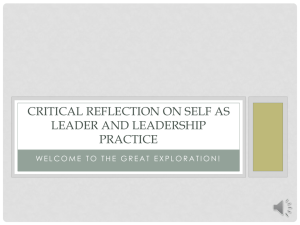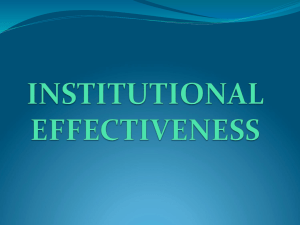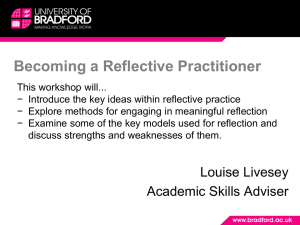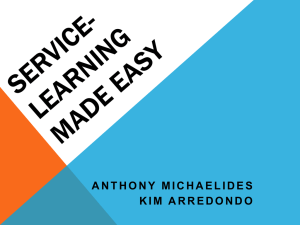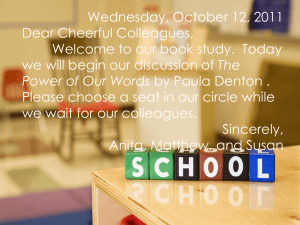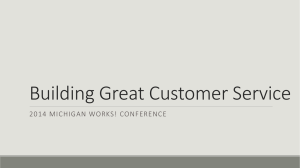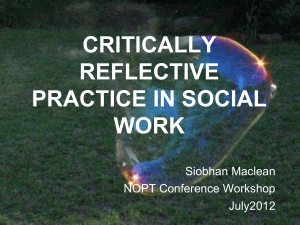Assessing reflection
advertisement
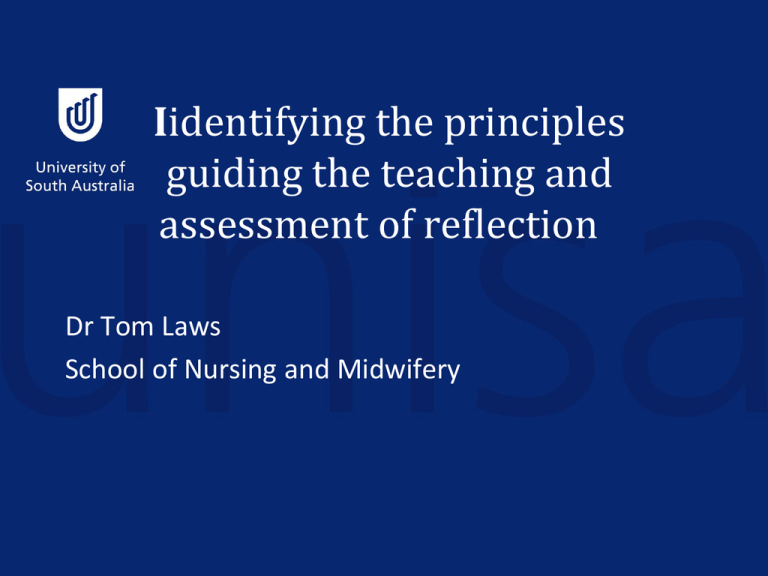
Iidentifying the principles guiding the teaching and assessment of reflection Dr Tom Laws School of Nursing and Midwifery Origins of reflection Seminal work: Donald Schön(1983, 1987) • Alerted professional educators to the inadequacies pure science (technical rationality) – Systematic problem solving • Supposition that a problem is identified • The ends are fixed and clear (pure science) Origins of reflection Schon’s comments on actual practice. Inherently – ‘messy, indeterminate situations’ characterised by … • uncertainty, • instability, • uniqueness and … • value conflict. Reflection – The theory Premise All understanding combines explicit and tacit components ….”frames of reference within which or against objects of experience can be interpreted” Ergo… reflection requires an understanding of which body of knowledge is being used to interpret experiences. Reflection – The theory Premise #2 Talking to yourself is …. the first sign of sanity Reflection – The theory Reflective practice (RP) Schon’s pedagogical model… • Reflection – in – action (surprise and puzzlement) • Reflection – on – action (a cognitive post-mortem) Reflection – The theory Limitations to Schon’s theory • incomplete • Little advice on how to operationalise the teaching and assessment of reflection • Protected practice is important but often … students discover the espoused theory does not equip them for real world practice (Greenwood, 1992) Why choose a reflective model? Drivers in nursing Historical relationship between gender development of the professions • Science and medicine (masculine) • Nursing and the holistic art (feminine) • Teacher education (feminine) also has a heavy emphasis of RP. Reflection: a requirement Project 2000 UK “Self-assessment is an important feature of outcomes-based education. For example, students may keep reflective diaries to describe and analyse their experiences of the process of learning”… (UKCC, 1999, p35 & 38). Reflection: a requirement Reflective practice is a statutory requirement for continuation of registration; the Conduct Statement 10 identifies that ‘Nurses practise nursing reflectively and ethically’ (ANMC, 2008). Reflection: a requirement Substitute goods (Approaches to learning) • Critical thinking (systematic reviews) • Inquiry based learning (IBL) • Problem based learning • Evidence based practice • Free thought! Preparation of teachers Nurse educators are not homogenous • Few with educational qualifications … – diversity of interpretation of what reflective learning is (Adams, 2011). • Many on short contracts – Tensions between those attempting to apply theory to practice and those in practice (Adams, 2011). Preparation of teachers Reports on faculty development mention RP interventions provided to nurse educators but … “there is a paucity of research demonstrating their effectiveness.” (Steinert et al., 2006:497) Preparation of teachers Braine (2009) study of new lecturers knowledge and affinity to reflective practice in teaching concluded … “…new lecturers need more preparation in the highly complex skill of reflection in order to facilitate the reflective learning process in their students”. Preparation of teachers Bulman et al’s thesis (2012) exploring social construction of reflection noted … • “The only contemporary study identified that specifically explored nurse teachers' perceptions of reflection was O'Connor et al. (2003)”. The challenge • Academics face the challenge of preparing students for a professional practice role that is underpinned by reflective processes. • Do we assess the process of RP or the outcome – is it feasible to do both? • Is there an evidence base to a RP model? EBP - Education Providing meta-evidence is difficult because • Educational processes evolve rapidly • lifespan of educational models varying according on the zeal and interpretations of their proponents, across disciplines and countries (Reed et al., 2005; Maudsley et al., 1999). EBP in teaching There is … “only limited evidence to support reflective journaling as an appropriate tool to promote reflection for the purpose of learning from practice for practice in undergraduate nursing education.”(Epp, 2008:1379). Student preparation Student Journals Dyment & O'Connell (2011) Assessing the quality of reflection: A review of the research “instructors fail to provide adequate training to their students to help them journal in effective ways” (Dyment & O'Connell, 2011: 236) Assessing reflection Limitations • Assessors lack achievable inter-rater reliability (Dyment and O’Connell (2012 ) • Ethical Issue: privacy-of-thought (Connell, 2012 ) • Knowing of assessment evokes emotions that perverts the quality of reflection (Cre`me, 2005). Assessing reflection • Without a substantive theory the sufficiency of self-monitoring activities is questionable (Eva, 2008:19). • self-assessment accuracy seems frequently unreliable (David et al., 2006) Assessing reflection Bulman et al’s (2012) Student and teacher perspectives: meaning of reflection (doctoral study) …” the danger is that students write what they think the marker will want to read” “students were very aware of the need to write an Reflective Learning contract (RLC) that would pass the assessment” Authentic assessments IBL • It is incumbent upon academics to chart the students’ development in accord with professional competencies and standards and then conduct authentic assessments for related learning activities (Pilcher& Bedford, 2012). • Does RP occur widely and is it part of every day practice? End users Hopkinson, study (2010). An inquiry into nurses' reflecting in the ward Reflection-in-action is a complex concept that has proved difficult to implement, assess and evaluate in every day practice End users Reflection, an everyday part of practice? RP is undermined by micro politics; unconscious games, paradoxes and contradictions. “we do it all the time, the paradox of the busy syndrome, the waiting game, whinging creating an emotional orgy, feeling unsupported by managers and talking behind your back”. (Hopkinson, 2010) End users The hierarchical structures contribute to the invalidation of the concept of genuine reflection. “The ward structure portrays reflection as an abnormal method of practice and knowledge development”. (Mantsoukas and Jasper, 2004:295). End users Benefits vs cost RP is portrayed as being positive and empowering to the individual and the profession. Analysis of RP discourse is seen as … • a tool of surveillance (thought police). • not emotionally cost-neutral • a governing tool (Fejes, 2008). RP: Difficult to sell My point is .. Few studies trace how reflection contribute to important changes and it is therefore often difficult to highlight the value of reflection to students who are keyed to expect evidence based practice (Duke and Appleton, 2008; Forneris & Peden-McAlpine, 2007; Mantzoukas & Jasper,2008). Student engagement Power relations for students mean .. • Reflection mainly on positives • Reflection is rarely on personal negatives • Write what they believe others want to hear • Universities are remotely interested in students (OUA) Evidence based teaching Chan’s (2013) conclusions for Critical thinking • the definition and concept of critical change over time making it necessary for educators to clarify their perspective towards CT • The same revision needs to occur for Reflective practice • If nursing is a science and an art how can you assess the subjectivity of the art? Questions please!

